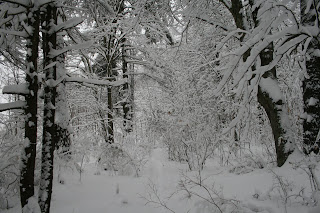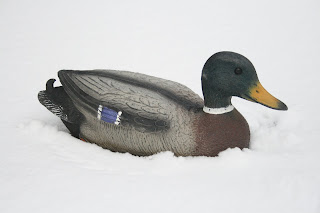 In winter, harlequin ducks feed among the crashing waves, as do rafts of common eiders and other sea ducks. The harlequin is a small sea duck that winters on the coast of Maine and breeds in fast flowing mountain streams in Newfoundland and New Brunswick. Its plumage is exquisite -- white patches and bands contrast with a blue gray body and chestnut sides. Click here to see a photo.
In winter, harlequin ducks feed among the crashing waves, as do rafts of common eiders and other sea ducks. The harlequin is a small sea duck that winters on the coast of Maine and breeds in fast flowing mountain streams in Newfoundland and New Brunswick. Its plumage is exquisite -- white patches and bands contrast with a blue gray body and chestnut sides. Click here to see a photo. In contrast, the common eider is a big, bulky sea duck. The male eider stands out in the crowd of eiders with its black and white body, green nape (neck), and sloping head with a pale green bill. The females are reddish brown with black barring. Click here for a photo of an eider pair from Massachusetts Audubon.
In contrast, the common eider is a big, bulky sea duck. The male eider stands out in the crowd of eiders with its black and white body, green nape (neck), and sloping head with a pale green bill. The females are reddish brown with black barring. Click here for a photo of an eider pair from Massachusetts Audubon. As the incoming tide covered beaches and sand bars, a flock of 25 purple sandpipers landed on the rocks at the edge of the surf. They hopped up to the top of the rock and rested in the sun, as waves crashed below their perch. The purple sandpiper is a plump, more slate-gray than purple, shorebird with a slightly curving bill and yellow legs and feet (click here for photo). They breed in the arctic and are one of the few sandpipers that winters this far north.
As the incoming tide covered beaches and sand bars, a flock of 25 purple sandpipers landed on the rocks at the edge of the surf. They hopped up to the top of the rock and rested in the sun, as waves crashed below their perch. The purple sandpiper is a plump, more slate-gray than purple, shorebird with a slightly curving bill and yellow legs and feet (click here for photo). They breed in the arctic and are one of the few sandpipers that winters this far north.Black scoters, with jet-black plumage and bright orange knob on the bill, swam among the eiders and harlequins. A pair of red-breasted mergansers floated by, their bills tucked into their backs. Four beautiful long-tailed ducks, in their winter whites, swam farther off-shore. White-winged and surf scoters remained even farther off-shore, visible only with a spotting scope. All the sea ducks were in their breeding plumage, already pairing up and chasing away unwanted male competition. We saw a lone common loon, still in its rather dull winter plumage.
As we drove south along the shore, we watched a small flock of buffleheads play in the water. Males chasing females, all diving and splashing. Not far away two male and one female common goldeneye were calmly swimming and diving. We ended our birding at the Nubble Lighthouse at Cape Neddick. Great cormorants roost off the north end of the island. Fewer people visit in winter, but in summer this place is bustling with tourists.

 We scanned the water at Nubble Light, taking in the last views of wintering sea ducks under a clear winter's day. I continue my tradition of visiting the coast in winter and avoiding it in summer. The reverse of most people, and that is the idea.
We scanned the water at Nubble Light, taking in the last views of wintering sea ducks under a clear winter's day. I continue my tradition of visiting the coast in winter and avoiding it in summer. The reverse of most people, and that is the idea.











































